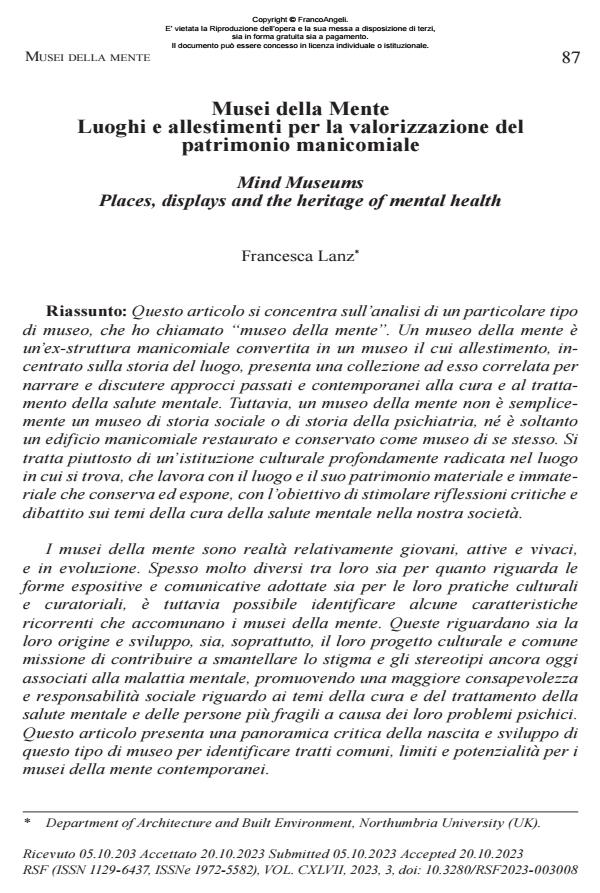Mind Museums Places, displays and the heritage of mental health
Journal title RIVISTA SPERIMENTALE DI FRENIATRIA
Author/s Francesca Lanz
Publishing Year 2023 Issue 2023/3
Language Italian Pages 15 P. 87-101 File size 672 KB
DOI 10.3280/RSF2023-003008
DOI is like a bar code for intellectual property: to have more infomation
click here
Below, you can see the article first page
If you want to buy this article in PDF format, you can do it, following the instructions to buy download credits

FrancoAngeli is member of Publishers International Linking Association, Inc (PILA), a not-for-profit association which run the CrossRef service enabling links to and from online scholarly content.
Asylums have left behind residues and remnants creating the contemporary landscape of the heritage of mental health. This paper focuses on museums that preserve and interpret that heritage. Although public museums were rarely found in a working asylum, forms of public display and collecting were common in these institutions since their inception. In the eighteenth century (and through to the early twentieth in some cases), it was common practice to allow in a paying public in some public madhouses, mad hospitals and asylums as an additional source of revenue. However, visiting the asylum was also meant to be a moral and educational experience, very much in light with the Enlightenment paternalistic attitude. At Bethlem, ‘the insane were displayed as a didactic spectacle’, the viewing was meant to ‘impress the minds and hearts of … visitors’ for it was essentially supposed to be a ‘moral experience through turning the mirror.’ [1: 183–184]. Precisely because of the moral implications of the spectacle of punishment involved in 18th and 19th century asylum visiting, as well as for the scopic regimes and the subtended power relations characterising asylum life and spaces, the asylum has been discussed in relation to museums and other institutions as part of the ‘exhibitionary complex’ [2]. However, while asylums gradually withdrew from the public sphere to become places of incarceration, ‘[t]he institutions comprising “the exhibitionary complex”, [became] progressively more open and public arenas’ (ibid.: 74). Asylums and museums constitute ‘different sets of institutions and their accompanying knowledge/power relations, then, whose histories, in these respects, run in opposing directions’ (ibid.). This paper explores how the separated histories of mental asylums and museums eventually re-merged into what I termed ‘mind museums’. A mind museum is a site-specific and place-based cultural institution hosted in the premises of a disused asylum whose work and displays primarily pursue a mission to promote awareness about mental care and treatment in the past and the present, and to contribute to dismantling stigma and stereotypes surrounding mental health today. In this paper I will define in outline a mind museum by tracing its origins within 19th century asylum collecting practices, framing their birth within the deinstitutionalization movement, and eventually discussing their more recent development with particular attention given to exhibition design. The critical analysis of mind museums’ exhibition design is here intended not only to describe how mind museums are, but also to understand what they do.
Keywords: adaptive reuse, heritage, former asylums, contemporary museums, musealisation.
Francesca Lanz, Musei della Mente. Luoghi e allestimenti per la valorizzazione del patrimonio manicomiale in "RIVISTA SPERIMENTALE DI FRENIATRIA" 3/2023, pp 87-101, DOI: 10.3280/RSF2023-003008